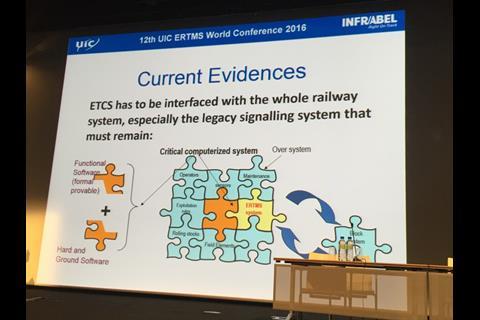ERTMS: ‘Train control is not enough’, suggested UIC Director-General Jean-Pierre Loubinoux in his opening remarks to the 12th ERTMS World Conference, hosted in Brussels last month by Infrabel. He argued that future signalling systems needed to move beyond simply block and speed control, and be integrated ‘more intensively’ with traffic management systems to improve regulation, train performance and energy saving.
Pointing out that ‘business is the new driver’, Loubinoux said a commercially-focused railway must optimise many factors including wear and tear on infrastructure and rolling stock as well as path costs, while meeting broader targets for both quality and safety. We have commented before about the drive for greater digitisation in the rail sector, and signalling clearly has a vital role to play in a data-driven world.
Whereas some railways had previously been reluctant to commit to investment in ERTMS, the message from speakers in Brussels — including Infrabel CEO Luc Lallemand — was more about the need for stability in the specifications to facilitate rapid deployment. Interoperability is a key goal but there are still many pitfalls along the way, such as the certification problems which recently saw all services suspended on one cross-border route between Luxembourg and Belgium.
Rail Cargo Austria CEO Reinhard Bamberger emphasised the challenges of trying to run freight trains across Europe in competition with road, air and water transport. Early deployments of ETCS had actually made things harder, he suggested, and operators were still looking for ‘positive results’. Any train control system needs to provide improved path availability, better traffic management and greater interoperability, he said, but above all it must be simple, reliable and cheap.
The latest ERTMS Baseline 3 Release 2 adopted earlier this year (RG 3.16 p12) has been widely welcomed as meeting most of the railways’ requirements, although the pace of development in the IT sector must cast doubts over how long any software-based technology can remain unchanged. The European Railway Agency has committed to keep future maintenance releases to a minimum, but its Executive
Director Josef Doppelbauer noted that further requirements are already emerging, including ATO and satellite positioning, as well as future results from the Shift2Rail research programme. He sees the way forward as ‘decoupling’ ETCS from legacy signalling and keeping a stable core as the ‘backbone’ to support a growing variety of applications.
With elements of ERTMS adopted by railways around the globe, both Doppelbauer and Loubinoux are looking forward to a Global or Universal Rail Traffic Management System. UIC has established its ERTMS Global project to ‘define the Functional Requirements of the rail operating sector’ both inside and outside Europe, which it hopes can be taken forward through its International Railway Standards initiative.
Citing ‘growing economic constraints’, Loubinoux said technical development must ensure that railways can earn a return on investment. Satellite train location could minimise the amount of trackside equipment to be installed and maintained in potentially hostile environments, as well as reducing the risk of theft. Given the rapid evolution of telecommunications, he proposed that ERTMS should in future ‘be able to work on any public or private network’, as long as its coverage and quality of service meet the requirements. However, cyber security is a concern in an increasingly IP-based world.
Virgin Trains East Coast’s Paul Boyle explained the implications for the operator of rolling out ETCS Level 2 on the UK’s East Coast Main Line, which at this stage is separate from Network Rail’s Digital Railway pilot project (RG 3.16 p28). The Hitachi-built trainsets being supplied under the Intercity Express Programme — now branded as Azuma (p26) — are coming with ETCS fitted, but much remains to be done before it goes live in 2019. Cab signalling may pave the way for the Azumas to run at 225 km/h, but an increase from 200 km/h could depend on grade-separating level crossings. And while ETCS is expected to increase the number of paths available, widening the speed differential between the fastest and slowest trains would have a negative impact on capacity.
Railways around the world have embarked on a huge variety of digitisation initiatives, and we will be exploring the scope for convergence between onboard intelligence and maintenance in our next RG:TV interactive live debate, The Convergent Railway, which takes place on May 17.
In a world with more on-rail competition, digitisation clearly raises more questions than answers. How far should operators be free to develop their own digital strategies? Could the integration of train control with other tools impact on interoperability? Does it require greater co-operation or re-integration across the wheel-rail interface? What of convergence between ETCS and proprietary CBTC systems in the light of ERTMS Global? And what are the implications of a wider digital remit for the railway supply sector?
However the digital revolution plays out, the over-riding priority remains the same — to maximise efficiency and competitiveness. Every railway needs to deliver a high-quality and reliable service at a price that users are prepared to pay.



















